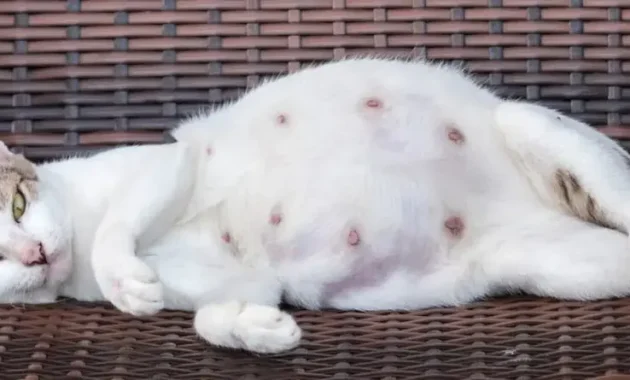Cats are fascinating creatures, and their reproductive biology is no exception. Pregnancy in cats is a complex process that involves intricate hormonal changes, physical adaptations, and behavioral modifications. One of the most noticeable changes during feline pregnancy is the enlargement and darkening of the nipples, which serve as vital structures for nurturing newborn kittens.
Understanding the anatomy and physiology of cat nipples can provide valuable insights into the stages of pregnancy, proper care for pregnant cats, and preparation for kitten arrival.
The purpose of this article is to explore the wonders and miracles of cat parenthood by focusing on one of its most visible signs: pregnant cat nipples. We will examine the role that nipples play in feline reproduction, how they change during pregnancy, and what these changes reveal about kitten development.
Additionally, we will discuss essential aspects of caring for a pregnant cat such as nutrition, exercise, medical checkups, and emergency planning. By gaining a deeper appreciation for cat nipple biology and pregnancy-related issues, readers can become better-informed pet owners who can provide optimal care for their feline companions.
The Role of Nipples in Cat Pregnancy
The role of nipples in cat pregnancy is a crucial aspect to consider as they signal the onset of pregnancy and serve as the primary source of nourishment for kittens. Cats usually have 6-8 nipples arranged in pairs along their bellies. Each nipple is connected to several ducts that lead to the mammary gland behind it, which produces milk.
Non-pregnant cats have small and dormant mammary glands, but during early pregnancy, nipple changes start to occur. Nipples enlarge and darken, and a patch of hairless skin develops around them. As gestation progresses, nipples become more prominent, and small amounts of clear or milky discharge might leak from them around day 60-65.
After birth, kittens immediately gravitate towards enlarged nipples for nourishment. The production of milk is crucial for their growth and development until they are weaned off it. Once nursing stops, nipples gradually return to pre-pregnancy size and appearance until the next litter arrives or if nursing starts again due to illness or injury.
Male cats also have nipples but do not serve any purpose in terms of producing milk unless there is an underlying medical condition present that requires treatment such as mastitis or breast cancer.
Changes in Nipple Appearance During Pregnancy
Enlargement, darkening, and the development of hairless patches around the mammary glands are early indicators of feline pregnancy. These changes occur due to an increase in hormonal activity during pregnancy. The nipples become more prominent and may appear swollen as they prepare for milk production.
Here are three key differences between normal cat nipples and those of a pregnant cat:
- Normal cat nipples are small and dormant, while pregnant cat nipples enlarge and darken.
- Mammary glands are behind each nipple, and only pregnant or nursing cats produce milk.
- Male cats also have nipples, but they don’t serve any purpose other than aesthetic value.
It’s important to note that these changes to the nipples indicate pregnancy but may not be present until several weeks into term. Additionally, not all cats will exhibit every symptom listed above, so it’s essential to monitor your pet closely for any signs of pregnancy if you suspect she is pregnant.
Stages of Kitten Development in Relation to Nipples
Throughout the course of a cat’s pregnancy, the mammary glands behind each nipple develop to prepare for milk production, and once kittens are born, their nourishment from their mother’s milk is crucial to their growth and development.
As the pregnancy progresses, the nipples become larger and more prominent, with a darker hue that helps guide the kittens to find them for nursing. The hairless patches around each nipple also swell during late pregnancy in preparation for milk production.
After birth, kittens immediately gravitate towards enlarged nipples for milk. The average number of nipples on a cat is 6-8 arranged in two rows along the belly. Each mammary gland has several ducts connecting to the teat canal through which milk flows.
Once weaned, the nipples gradually return to pre-pregnancy size and appearance as they are no longer stimulated by nursing. It is important for mother cats to produce enough milk during this time as it is crucial for the proper nourishment and growth of the kittens.
Proper Care and Nutrition for Pregnant Cats
Adequate nourishment and care are essential for maintaining the health of a feline throughout its pregnancy. Pregnant cats require a diet that is high in protein and fat to support their developing fetuses, as well as an increased intake of vitamins and minerals. It is recommended to provide pregnant cats with specialized food formulated for their nutritional needs, which can be prescribed by a veterinarian.
In addition to proper nutrition, pregnant cats also require appropriate care. This includes creating a comfortable nesting area where they can rest and give birth, providing regular veterinary check-ups to monitor the health of both the mother cat and her fetuses, and ensuring that she receives enough exercise without overexerting herself.
Owners should also be aware of signs of labor, such as agitation or refusal to eat, so they can prepare for the arrival of new kittens.
Preparing for the Arrival of Kittens
Preparing for the arrival of kittens involves creating a safe and comfortable space for them to grow, play, and thrive. This involves setting up a nesting area that is free from drafts and has easy access to food, water, and a litter box.
The mother cat will also need a private area where she can nurse her kittens without interference. It is important to keep this area clean and disinfected to prevent the spread of disease.
During the early stages of pregnancy, the mammary glands behind each nipple start to develop in preparation for nursing. After birth, kittens rely on their mother’s milk as their primary source of nourishment.
Female cats have 6-8 nipples arranged in two rows along their bellies which become enlarged and more visible during late pregnancy. These changes help guide newborn kittens toward their mother’s nipples so they can begin suckling immediately after birth.
Male cats also have nipples, but they do not serve any purpose in nursing offspring.
The Bond Between Mother Cat and Kittens
The bond between a mother feline and her kittens is a remarkable display of nurturing instincts and affectionate care. From the moment they are born, the mother cat provides everything her kittens need to survive and thrive. This includes warmth, milk, grooming, protection, and guidance as they learn to explore their surroundings.
Here are three ways in which this bond manifests itself during different stages of pregnancy:
- During early pregnancy, the mother cat may become more maternal and seek extra attention from her owners.
- In late pregnancy, the mother cat will start preparing for labor by searching for a secluded place where she can give birth safely.
- After giving birth, the mother cat will devote most of her time and energy to nursing and caring for her newborns until they are old enough to venture out on their own.
To ensure a healthy cat pregnancy and successful litter arrival, it is important to monitor changes in your pregnant cat’s behavior closely. One way to tell if your cat is pregnant is by checking for changes in her nipples – pregnant cats have pairs of nipples that become visibly larger during pregnancy compared to non-pregnant cats.
By knowing how to tell the difference between normal versus pregnant-cat nipples you can better prepare yourself for caring for your new litter once they arrive.
Postpartum Changes in Nipples and Milk Production
After giving birth, the mammary glands of female felines undergo significant changes in preparation for milk production and nourishment of their newborn kittens. The nipples, which were enlarged and more visible during pregnancy, become even larger and darker in color to help the kittens find them easily. In addition, hairless patches around the nipples swell to provide more surface area for nursing.
Milk production starts soon after birth as the kittens suckle on the nipples. The amount of milk produced depends on various factors such as the number of kittens, frequency of nursing, and the mother’s health. Generally, a healthy cat will produce enough milk to feed its litter for several weeks until they start weaning onto solid food. However, if you notice any abnormalities or concerns about your cat’s milk production or nipple changes postpartum, it is important to consult your vet for advice and guidance.
The Joys and Challenges of Cat Parenthood
Raising a litter of kittens can be both rewarding and challenging, as it involves providing round-the-clock care for the newborns while ensuring their mother is healthy and well-nourished.
As the kittens grow, they will rely on their mother’s milk for nourishment, which means that her nipples will play a crucial role in their development. It is important to note that there are differences between normal cat nipples and pregnant cat nipples.
During pregnancy, the area around the nipples will become enlarged and darker in color to help kittens find them more easily. Male cats also have nipples, but they do not serve any purpose in producing milk.
Cat parenthood requires careful attention to the needs of both mother and kittens. In addition to ensuring that the mother is well-fed and hydrated, pet owners should monitor her closely during labor and delivery to ensure that everything goes smoothly.
After birth, it is important to keep the kittens warm and clean while making sure that they are nursing properly. As they grow older, they will need a balanced diet consisting of high-quality kitten food along with plenty of playtime and socialization opportunities.
Overall, raising a litter of kittens can be an incredibly rewarding experience for pet owners who are willing to put in the time and effort necessary for their care.
Frequently Asked Questions About Pregnant Cat Nipples
Q: What are normal cat nipples like?
A: Normal cat nipples are small, smooth, and generally the same color as your cat’s skin. Cats have either six or eight nipples, evenly spaced along their underside.
Q: How can I tell if my cat is pregnant?
A: One of the first signs of cat pregnancy is a change in your cat’s nipples. They will become enlarged, usually within the first few weeks of pregnancy. Your cat may also exhibit other symptoms such as morning sickness or a nesting instinct.
Q: How do pregnant cat nipples differ from normal ones?
A: Pregnant cat nipples will become larger and more pink or reddish in color. You may also notice them developing a slightly rougher texture than normal cat nipples.
Q: When do cats’ nipples start to change during pregnancy?
A: Cat nipples will typically start to change within the first two to three weeks of pregnancy.
Q: Do all female cats have nipples?
A: Yes, all female cats have nipples. They are an essential part of a cat’s mammary system, which allows them to nurse their offspring.
Q: Can male cats have nipples too?
A: Yes, male cats can have nipples, although they serve no functional purpose in their physiology.
Q: What does a pregnant cat’s nipples look like?
A: Pregnant cat’s nipples will become larger and more pink or reddish in color. They may also start to look more raised or prominent than normal cat nipples.
Q: Can an odd number of nipples in a cat’s litter indicate pregnancy?
A: No, the number of nipples in a cat’s litter is not an indication of pregnancy. However, if a female cat has enlarged or reddened nipples, it may be a sign that she is pregnant.
Q: How long does a cat’s pregnancy last?
A: A cat’s pregnancy usually lasts around 63-65 days, similar to human gestation periods.
Q: Is it normal for a cat’s nipples to become larger or change color during its heat cycle?
A: No, it is not normal for a cat’s nipples to change during its heat cycle. However, these changes are common during pregnancy.
Q: Is it necessary to monitor my cat’s nipples during pregnancy?
A: While monitoring your cat’s nipples during pregnancy is not necessary, it is a good way to keep track of your cat’s health and ensure that she remains healthy throughout her pregnancy.
Conclusion
In conclusion, the nipples and mammary glands of cats play a crucial role in their reproductive system. Changes in nipple appearance during pregnancy can indicate the onset of pregnancy, as well as the progression of fetal development. Proper care and nutrition are essential for pregnant cats to ensure healthy offspring.
Preparing for the arrival of kittens involves creating a safe and comfortable environment for both the mother cat and kittens. The bond between mother cat and kittens is an incredible sight to behold, with the mother providing warmth, nutrition, and protection to her young.
Postpartum changes in nipples and milk production occur as the mother’s body adjusts to caring for her litter. Pet insurance can be beneficial for unexpected expenses related to emergency surgeries or other veterinary needs during this time.
Overall, understanding the anatomy of cat nipples and mammary glands is important for pet owners who want to ensure their feline friends have a happy and healthy pregnancy experience.


